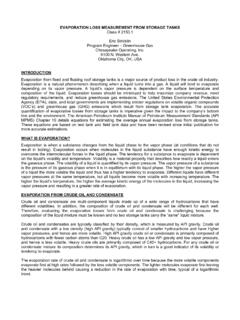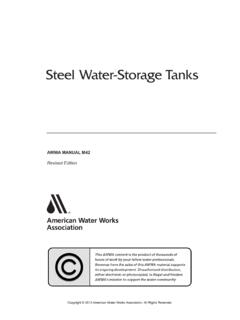Transcription of Cleaning and disinfecting water storage tanks and tankers
1 TECHNICAL NOTES ON DRINKING- water , SANITATION AND HYGIENE IN EMERGENCIES Updated: July NOTES ON DRINKING- water , SANITATION AND HYGIENE IN EMERGENCIESC leaning and disinfecting water storage tanks and tankers3In an emergency situation, it is often necessary to quickly provide a basic water supply for the affected population. This may be because the normal systems of supply have been damaged or destroyed. The most common, immediate solution is to hire vehicles and tanks that have been used for other purposes or to retrieve collapsible tanks from an emergency store. In either case, they must be cleaned and disinfected before being used. This technical note outlines a four-step approach to Cleaning and disinfecting water tanks and Steps for Cleaning and disinfecting water tanks and tankersProcedural steps In the case of an emergency, it is an accptable practice to disinfect tanks that are polluted or not in use so that drinking- water can be transported and stored safely.
2 Figure presents the four-step approach to Cleaning and disinfecting water : Large quantities of clean water will be required to clean and treat tanks before they can be used to transport or store 1: Select the tanks to useTanks should be selected based on three considerations: normal use; ease of Cleaning and water storage tanks should only have been used for holding food-grade liquids, for example, milk, cooking oils, fruit juices, wines and spirits or vinegar. tanks previously used for holding non food-grade liquids such as fuel and sewage should not be used. tanks that previously held water but have been out of use for some time must also be cleaned and disinfected as described below under Steps 2 and must be easy to clean. This means they must be accessible for Cleaning and have no sharp corners that may hold dirt and so prevent the removal of food will only remain clean if stored safely.
3 tanks must therefore be covered and fitted with an access point with a lockable 2: CleaningEmpty the tankOpen the outlet valve or tap and drain out any remaining liquid . Collect the liquids so that they can be safely disposed of (see Step 4). In the case of tankers , outlet valves are usually located at the back so parking it on a slope will help to ensure that all the liquid can be discharged (see Figure overleaf). Permanent storage tanks are usually fitted with a washout valve that draws liquid from the base. Use this, rather than the normal outlet valve, for emptying. Step 4:Safely dispose ofliquid wasteStep 1:Select the tanks and tankers to useStep 2:Clean the tanks and tankersStep 3:Disinfect the tanks and tankersScrub the internal surfaces of the tankUse a mixture of detergent and hot water (household laundry soap powder will do) to scrub and clean all internal surfaces of the tank.
4 This can be done with a stiff brush or a high pressure jet. Attaching the brush to a long pole may make it possible to clean the tank without entering it (Figure ). NOTES ON DRINKING- water , SANITATION AND HYGIENE IN EMERGENCIESC leaning and disinfecting water storage tanks and tankersFigure Discharging liquids from tanks and tankersTake special care to clean corners and joints so that no small amounts of the original liquid remain. Even minute amounts of some liquids can give the water a bad taste and people will refuse to drink it. Leave the outlet valve open while Cleaning and collect the liquid for safe and flush the tankThis is most easily done with a high pressure hose pipe or water jet but if they are not available the tank can be filled with (preferably hot) water and left to stand for a few hours. Drain all the water from the tank and collect for safe disposal as before.
5 Continue flushing the tank until there are no longer traces of detergent in the 3: DisinfectionThe most common way of disinfecting a water tank is by chlorination. Chlorine is delivered in a variety of ways but the most common is high-strength calcium hypochlorite (HSCH), which, when mixed with water , liberates 60 to 80% of its volume as the volume of the tankThe amount of chlorine needed to disinfect the water tank will depend on its volume. Box describes how to calculate the volume of common tank parked onslope or rampto let water out2-wheeled donkeycart on end tolet water outNormal storage tank outletWash-out pipeWash-out valveImportant note: Tank Cleaning should take place in open areas away from houses to avoid possible health problems resulting from the disposal of the hosesThe hoses, pumps and pipes used for filling and emptying the tank must also be cleaned. Flush a mixture of hot water and detergent through the pipes and pump to remove deposits and other waste material.
6 Once cleaned, flush the system with clean water to remove the Cleaning the inside of a tank with a NOTES ON DRINKING- water , SANITATION AND HYGIENE IN EMERGENCIESC leaning and disinfecting water storage tanks and tankersBox Calculating the volume of a tankStorage tanks are commonly one of three shapes, rectangular, cylindrical or oval. If the tank is another shape, approximate its volume by using the formula that most nearly fits the ground storage tanksVolume (litres) = L x W x D x 1000 WhereD = depth of the tank (m)W = width of the tank (m)L = length of the tank (m)Cylindrical ground storage tanksVolume (litres) x 1000 WhereD = diameter of the tank (m)L = length of tank (m) = water tankersVolume (litres) = ( x (D + W)2 /16) x L x 1000 WhereD = depth of the tank (m)W = width of the tank (m)L = length of the tank (m) = the disinfectantFill the tank a quarter full with clean water .
7 Sprinkle 80 grams of granular HSCH into the tank for every 1000 litres total capacity of the tank. Fill the tank completely with clean water , close the lid and leave to stand for 24 hours. If the tank is required for use urgently, double the quantity of chlorine added to the tank. This will reduce the time of disinfection from 24 to 8 hours. disinfecting the hoses and pump If the tank is fitted with a pump, connect the hoses so that water is drawn from and returned to the tank (Figure ). With the tank full of water and disinfectant, start the pump so that the mixture passes through the hoses and pump. Run the pump for about an hour. Repeat this procedure with the tank full of clean no pump is fitted, use some of the disinfectant from the tank and gently fill the hoses to full capacity. You will have to block one end of the hose and fill it from the other end. Allow to stand for 24 hours.
8 Empty out the disinfectant and connect the hoses to the tank outlet so that when the clean water in the tank is discharged it passes through the hoses. The hoses are now ready for for useCompletely empty the tank and carefully dispose of the disinfecting water as it will contain a high concentration of chlorine. Fill the tank with drinking- water , allow to stand for about 30 minutes then empty the tank again. The tank is now ready for (Right) Recirculating chlorinated water to disinfect the pump and hosesLDLDWLWD = D2 L 4 Further informationDavis, J. and Lambert, R. (2002) Engineering and Emergencies: A practical guide to fieldworkers, 2nd Edition, Practical Action Publishing, Department of Environmental Protection (Undated) Procedures for Emergency Tank Truck Bulk water Haulage. Department of Health and Hospitals (Undated) Instructions for Emergency Tank Truck Bulk water Hauling in Louisiana.
9 And disinfecting water storage tanks and tankersPrepared for WHO by WEDC. Authors: Sam Godfrey and Bob Reed. Series Editor: Bob Reed. Editorial contributions, design and illustrations by Rod Shaw Line illustrations courtesy of WEDC / IFRC. Additional graphics by Ken Chatterton. water , Engineering and Development Centre Loughborough University Leicestershire LE11 3TU UK T: +44 1509 222885 F: +44 1509 211079 E: W: , Sanitation, Hygiene and Health UnitAvenue Appia 201211 Geneva 27 SwitzerlandTelephone: + 41 22 791 2111 Telephone (direct): + 41 22 791 3555/3590 Fax (direct): + 41 22 791 4159 URL: World Health Organization 2013. All rights reserved. All reasonable precautions have been taken by the World Health Organization to verify the information contained in this publication. However, the published material is being distributed without warranty of any kind, either expressed or implied.
10 The responsibility for the interpretation and use of the material lies with the reader. In no event shall the World Health Organization be liable for damages arising from its access and working inside a water tank can be difficult and dangerous. There is often only a small access hatch on the top of the tanker through which to climb in and out. Cleaners should be aware that some liquid held in tanks can give off hazardous gases which may remain even when the liquid has been removed. The liquids may also pose physical hazards such as slippery surfaces. Corrosive liquids can cause blow fresh air into the tank for a period before allowing a person to enter. The cleaner should wear protective clothing, including gloves, boots, a hat and glasses (Figure ). Make sure someone remains outside the tank, next to the access hatch all the time in case the cleaner has an accident. The availability of gas masks and portable ventilators would be an Wearing protective clothing for cleaningStep 4: Safely dispose of liquid wasteCare must be taken when disposing of all liquids used for Cleaning and disinfecting the tanks .
















